Batsmen at all levels of cricket should be asking themselves how they improve their ability to bat against fast bowlers. Fast bowlers are the most common type of bowler that you will face, therefore you will need to have a deep range of skills that you can call on in order to combat them. You’ll need a sound mind that is able to concentrate for long periods, and you’ll need strong attacking and defensive skills that you can use when the situation calls for them. You’ll also need to be sure that you’re comfortable playing on the back foot as well as the front foot. In this post I hope I’ll be able to help you to build all of those skills as well as many others!
In addition to the tips I’ll be sharing with you, I’ll also share several different drills that you can use to work on specific bits of your technique.
To improve your batting against fast bowlers, I’d recommend the following tips:
- Make Sure You’re Wearing The Correct Protective Gear
- Stride Out to the Crease With Purpose
- Take a Guard That Will Emphasise Your Batting Strengths
- Use a Batting Stance That Allows You To React Quickly
- Consider Using A Trigger Move
- Think About Lowering Your Backlift
- Watch The Ball Like Your Life Depends On It
- Don’t Go Too Big, Too Early
- Be Positive With Your Footwork
- Work On Your Defensive Game
- Develop Several Attacking Options You Can Use
- Work On Playing and Evading the Short Ball
- Try To Put The Bowler Off Their Line & Length
- Rotate The Strike Regularly
- Take Field Placings Into Account When Playing Your Shots
- Try New Ways Of Testing Yourself Against Fast Bowling In Practice
- Practice Regularly – With Your Club & At Home
I’ll now go through each of these tips 1 by 1, explaining why each is vitally important to your batting success against fast bowlers. If you can work on each of these things in your practice sessions and bring them into a game, you should be much better prepared to take on quick bowling! Let’s begin…
Make Sure You’re Wearing The Correct Protective Gear
If you’ve played any real cricket at all, then you’ll know how hard a cricket ball is. It’s certainly not nice to get hit by one! It’s even worse when you get hit by a cricket ball that is delivered by a fast bowler.
If a fast bowler is sending the ball towards you at 70/80/90mph, then you will need to wear some equipment to protect sensitive areas of your body. Sensitive areas that you will definitely have to protect include; the head, the hands, the groin & the knees/lower legs. To protect these areas, you’ll need to make sure you purchase the following items:
- A helmet
- A pair of batting gloves
- An abdomen guard (also known as a box or a cup) to protect the groin
- A pair of batting pads
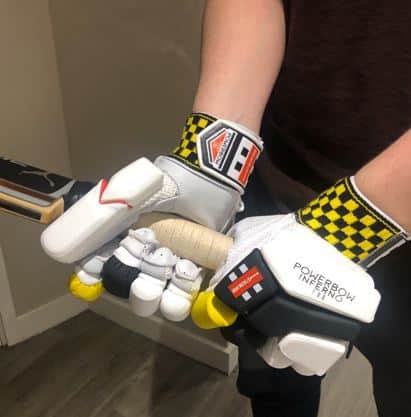
As well as the items listed above, certain batsmen may feel more comfortable if they’re using an arm guard, a chest guard and thigh guards etc. These aren’t essential protective items, but if they make you feel more confident when you bat it may be worth investing in them.
If you don’t wear the essential protective equipment and you get hit on the head, or on the hand, this could keep you out of action for a long time due to a concussion or broken fingers! No one wants to be stopped playing cricket due to easily avoidable injuries, so get yourself some protective gear and make sure you use it whenever you bat.
Stride Out To The Crease With Purpose
If we’re going to succeed as batsmen, we have to have confidence in ourselves. If you don’t truly believe you’ve got what It takes to face a fast bowler, then you’re putting yourself at a huge disadvantage before you’ve even faced a ball. Ideally, when we face quick bowling we want to be on our toes, alert and ready to react sharply to the ball. Doubting ourselves too much and getting excessively nervous before and during your innings can cause your decision making and your movements to become a lot more static and slow, which is the last position we want to be in!
I’ve struggled with nerves myself, especially when it came to facing the quickest bowlers in my age group, and that’s why I decided to make some changes to the way I went about things. I decided that before each innings, I would try to get myself in the best mental state possible, because a batsman who exudes confidence is not only going to play better, but they’re also going to show the other team that they can’t be intimidated.
If you walk out slowly to the crease, with bad posture, eyes looking at the ground, you’re more likely to show the opposing bowlers that you’re afraid, and they can use this to their advantage. Contrast that with a batsman who jogs out to the pitch, doing some shadow batting, greets the umpire and makes eye contact with the fielders. This batsman looks like they mean business and are very comfortable in this environment – and that is something we should always be trying to project! Batting is just as much of a mental challenge as it is a physical one, and those mental games can begin straight away as you’re approaching the wicket. Start striding out there with your head held high and remind yourself that you’re fully capable of scoring runs against any bowler on show.
If you’re someone who really struggles with intense nervousness before batting, I’d recommend clicking here to read the guide I wrote on how you can calm those nerves down and move from a more negative mindset to a positive one. That post covers a lot of techniques that I’ve used over the years and it should help you to kill some of the nervous energy, as well as allowing you to feel a lot more confident as you walk to the crease.
Take A Guard That Will Emphasise Your Batting Strengths
If you’ve not heard of the phrase ‘taking guard’ before, then allow me to briefly explain what it means. Taking guard basically refers to the position that the batsman will stand in when they are batting. More specifically, it refers to the alignment of the front of their shoes on the crease. For example, if the batsman has the front of their boots in line with their off stump, this is referred to as an off stump guard. If they have the front of their boots aligned with the leg stump, this would be classed as a leg stump guard. A middle stump guard would require the batsman to align the front of their boots with the middle stump. Different batsmen will stand in different positions, and the choice between each kind of guard can depend on what sort of strengths and weaknesses you have as a batsman.
If you’re a batsman who is particularly good at hitting the ball through the leg side, then you may want to take an off stump guard. By moving slightly further across to the off side in this way, this will mean that a slightly higher percentage of the bowlers’ deliveries will be on the line of your body or going down the leg side, and as a result you can play to your strength and hit the ball in that region. This type of guard would not be very suitable for someone who gets out LBW regularly, because it forces you to position your pads directly in front of the stumps. This is an attractive target for any fast bowler!
If you’re a batsman who is very strong at striking the ball through the off side, you may wish to back away to the leg stump slightly by taking a leg stump guard. This will give you that little bit of extra room that you need to free your arms and hit the ball in to the off side more regularly. However, this guard does cause you to open up your stumps a lot more, giving you a higher chance of getting out bowled.
Before you make a decision on which one to use, I’d recommend reading all of my advice on the different types of guard by clicking here. That post contains all the info that you’ll need to make a choice that suits you. By picking the right guard, you can open up your scoring opportunities and force fast bowlers to adopt strategies that they may not be comfortable with.
Use A Batting Stance That Allows You To React Quickly
Our batting stance is the foundation of our batting technique. If we have a good, solid starting position, it can allow us to react to the ball and play our shots much quicker. Everyone has different types of stances that they find the most comfortable but I think there are a few general rules we should all stick to that will prepare us well for facing quick bowling. Here are some of those:
- Position your feet roughly shoulder width apart
- Bend your knees slightly
- Turn your head fully towards the bowler so you can see them approaching
- As the ball is about to be released, keep your head and eyes level
These 4 things are quite basic but they will help to ensure that you’re in a decent position, allowing you to react to the ball quickly. Some stances will allow you to do this faster than others. For example, consider one player that has a batting stance where their feet are shoulder width apart. Now, imagine another player has their legs extremely wide, almost to an uncomfortable level. Which is the position that is going to keep you balanced and allow you to explode towards the ball quicker? I hope that your answer was the first stance! Batsmen who have their feet too wide apart or too close together won’t be properly balanced at the crease, and won’t be able to move forwards or backwards with as much speed and precision as the player who has their feet shoulder width apart.
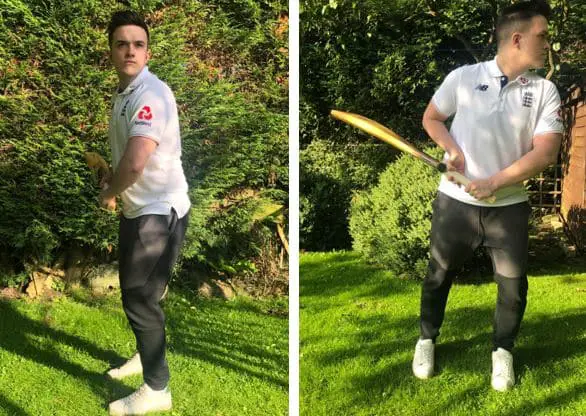
Similarly, bending your knees in your stance is a much more explosive position than if you stand bolt upright with straight legs! Bending your knees also helps to put more of your weight onto the balls of your feet, which is where our movements are launched from. This is much better than having our weight on our heels, from which it will take us slightly longer to move to play our shots.
If you want to change your batting stance, or you’re interested in reading more about different ways of doing things, click here to read the post I recently wrote on that topic. It’s important to emphasise that all cricketers are different and will have different things that work for them, but getting the basics right can make things a lot easier for you in the long run.
Consider Using A Trigger Move
A trigger move is a small shift of our body position that batsmen will make just before the bowler releases the ball. It usually involves a small adjustment of the position of our feet, and it helps to get ourselves into a position from which we can easily play a front foot or back foot shot. Some players also use it as a way of getting their feet moving prior to the bowler delivering the ball, because they think that they will be able to be react faster to a quick delivery if they are already moving rather than having to start from a static position!
Some batsmen have no trigger move at all. Probably the best example of this is Sachin Tendulkar – who is one of my favourite batsmen ever and one of the greatest of all time. He would stay perfectly still as the bowler was approaching and react from a stationary position. He showed us that trigger moves aren’t essential if you want to face the quickest bowlers.
On the opposite end of the scale is someone like Steve Smith, who has a large trigger move which sees him start from a leg stump guard before making a huge stride across to the off stump with his back foot. You can see Steve Smith’s trigger movements laid out in my photos below! This works perfectly well for him, and it has allowed him to be one of the best modern-day test batsmen that the cricket world has seen.
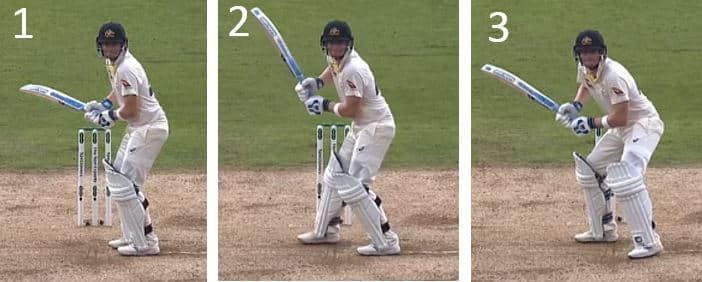
If you’re wanting to design your own trigger move, then you should try to make sure that you end up being a position with 70% of your weight on your front foot. With your weight on your front leg, you can easily continue to push on to the front foot if you receive a full ball, and if you receive a short ball you can quickly push back off that front foot to play a back foot shot. The pictures below show Kevin Pietersen’s transition from his batting stance in picture 1 to the end of his trigger move in picture 3. You can see that he is in a much better position to receive the ball in picture 3 than he is in picture 1, with his feet closer together and his weight over his front leg.
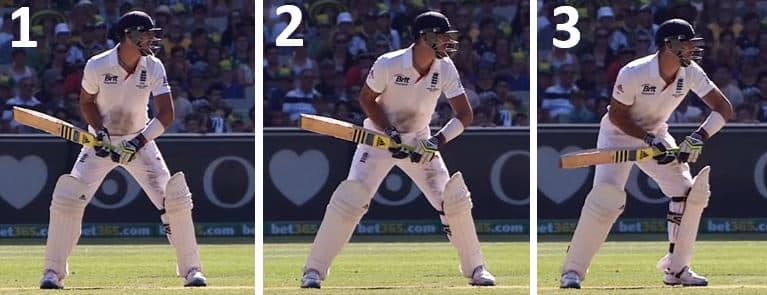
If you’re a young batsman, or if you’re a senior batsman but you don’t face extremely quick bowling that often, then you may not want to dedicate the amount of time and practice required to developing a trigger move. It’s a long process, and making it a reliable and repeatable movement that you can use without thinking takes a lot of work. If you do want to add this to your game, then the movement will have to come naturally to you, and you will have to work on it for a long period of time. Always remember to keep your head and eyes level as you make your move!
Think About Lowering Your Backlift
Your ‘backlift’ basically refers to how high you lift your bat up behind you during your backswing before playing a shot. Some batsmen like Brian Lara have naturally high backlifts where the bat will extend high above their head before they bring it down to play their stroke, whereas other batsmen will not bring the bat up anywhere near as high. You can see an example of a very high backlift below.
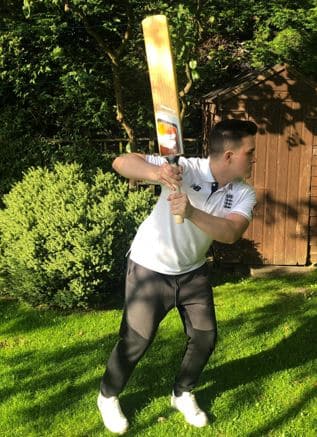
Depending on the game situation, we may want to alter the height of our backlift to make it easier for us to bat against fast bowlers. I recall an interview with Michael Atherton where he was talking about facing Waqar Younis and Wasim Akram at the peak of their international careers. Both Wasim and Waqar were incredibly quick bowlers, capable of reverse swinging the ball and bowling deadly yorkers. To try to combat these two, Atherton would purposely lower his backlift. This meant that he didn’t have to bring the bat down as far, or as quickly in order to meet the ball and play a shot. Think about it, if you lift the bat high above your head before you hit the ball, it’s going to take you a split second longer to get the bat down to the ball. This split second could be the difference between you being able to defend the ball and it sneaking through your defences and smashing into your stumps!
If you think you have a higher backlift than most people, don’t worry too much. Players with high backlifts can still be incredibly successful – as Brian Lara so brilliantly proved! However, if you do feel like it’s causing you problems against a specific bowler, you can work on lowering it in your practice sessions. Being able to do this may help you to survive a nasty spell from an opposition fast bowler! This is usually a last resort for me but it can definitely be effective if used in the right circumstances.
Watch The Ball Like Your Life Depends On It
If you don’t watch the ball properly while batting against fast bowlers, then you’re not going to be able to survive. Watching the ball is the key to batting against all types of bowlers, but it’s especially important when it comes to facing the quickest ones! To have any chance of reacting to the ball and playing the appropriate shot, you need to watch it from the moment it leaves the bowlers hand, right on to the face of your bat.
I think it helps a lot if you get into a routine of talking to yourself in between each delivery. As the bowler is approaching the crease, whisper ‘watch the ball’ to yourself over and over. This helps to keep your mind focused on what you should be doing. Many batsmen will get out to the crease and be so overcome with nerves or thoughts about their technique that they forget to watch the ball properly, and if this happens, you’ll have to get incredibly lucky to play a good innings. Use your net sessions to get into the habit of repeating ‘watch the ball’ before each delivery. Also, try to make sure that you’re watching the ball throughout the bowlers entire run up to the crease. This makes it easier for you to track it once it is released.
Don’t Go Too Big, Too Early
All batsmen require a brief period to get comfortable with the pace of the bowler, the pace and bounce of the pitch, and the movement of the ball when they arrive at the crease. It is incredibly hard to play fluently and hit the ball cleanly from ball number one! Therefore, my advice is that unless you are in a game situation where you have to score extremely quickly, don’t put too much pressure on yourself to have a fast start to your innings.
I’ve known a lot of impatient batsmen in my years of playing cricket. Many of them would get to the crease, get held to 0 runs off their first 4 or 5 balls and then try to hit a 6 off their 6th ball. Most of the time, they would miss the ball completely, or just slog it straight up in the air and get caught by a fielder!
It takes time to adjust to the pace of fast bowling, so make sure you allow yourself that time if the game situation permits it. Why not try using your first 10 deliveries to get used to the conditions, and then you can try to accelerate after that? Obviously if you get a really bad ball within your first 10 deliveries, you should be trying to hit it for a boundary, but if you get 5 or 6 really good balls, it’s fine to leave them alone. Don’t feel bad about it – it happens to everyone, even the professionals!
Be Positive With Your Footwork
Decisive footwork is key when it comes to batting against fast bowlers. If the ball is full, we should be getting ourselves as far forward as is comfortably possible, bringing our front foot close to the ball. If the ball is short, we should be pushing ourselves back into our crease and standing tall to get on top of the bounce.
Problems begin to occur when batsmen don’t move their feet positively, and this is especially likely to happen at the start of an innings. If you don’t move your feet, this is what we refer to as being ‘caught on the crease’. You are not coming forward to meet the ball, nor are you moving back to get on top of the bounce. If the ball is wide of the off stump, you won’t be using your feet to get yourself closer to the line of the ball. This leads a lot of batsmen to lunge at the ball with their bat instead, which makes it much more likely that you will get an edge on the ball. This can easily result in a dismissal!
Instead you should focus some of your practice sessions on your footwork. Two simple practice drills that I really enjoy are the drop ball drill, and the cone drill. They can really help you to get your feet moving at the start or a practice session or just before you begin your innings. Here’s how they work:
The Drop Ball Drill
Get a partner to stand around a metre away from you, holding a tennis ball in their hand. You should be in your batting stance, ready to stride forwards and play the ball. When your partner drops that ball, your task is to wait for it to bounce before moving your front foot forwards, and striking the ball with your bat. Get your partner to drop the ball in different locations so you can test out playing different front foot shots.
The Cone Drill
This drill is just as simple to perform. All you’ll need is a few balls and a few cones that you can balance the balls on top of. Once you have these items, place the balls on the cones about half a metre in front of you. Place one in the position in which you would hit a cover drive, place one in the area for a straight drive, and place one in the correct position for an on drive. With the cones in position and the balls on top of them, you should move your front foot towards each of them 1 by 1 and strike the ball. Focus on maintaining a good body position throughout and playing the shot in the correct technical way.
These two footwork drills are two that I use regularly. If you want to read the rest of my tips that will help you perfect your batting footwork, click here.
Work On Your Defensive Game
Even though we would like to play in an attacking way all the time, sometimes it just isn’t possible! Sometimes we will be batting in tricky conditions, or against a bowler who is just too much of a threat. In these moments, we may wish to adopt a defensive strategy to get through the tough periods without losing our wicket.
If you’re going to play defensively as a batsman, especially against a fast bowler, you’re going to need to be able to do a few things:
- Play a strong forward defensive shot
- Play a strong back foot defensive shot
- Learn to leave the ball on length and line
Forward defensive shots require you to step forwards with your front foot towards the pitch of the ball, and use the bat to deflect the ball straight down to the ground. You should only really be playing this shot to deliveries that you think may hit the stumps or your pads, otherwise you can just leave the ball and let it pass by you.
Back foot defensive shots are played by pushing backwards into your crease, bringing both your feet together and standing tall. The bat should come through vertically and be angled towards the ground, helping to deflect the ball quickly to the floor away from fielders. This type of shot is played to back of a length balls and short balls that are between hip and chest height and targeting the body. Any balls of this length that are wide of the off stump or the leg stump can be left alone entirely!

Learning to leave the ball is another skill that batsmen should work on. Some deliveries just don’t need to be played at, and it’s fine to let them pass without offering a shot. This frustrates the bowlers and can force them to bowl in areas that are more favourable to you.
If you want to practice your defensive batting abilities, why not set that as your goal for an entire net session? Tell yourself that you’re only going to defend the ball or leave it, and set yourself the goal of not being dismissed. Setting challenges like this for yourself in practice will prepare you well for similar situations that occur during a game.
Develop Several Attacking Options You Can Use
We will never fully know how to bat against fast bowlers unless we can attack them, and for that you will need a wide range of shots at your disposal. Some of the shots that I’d recommend learning how to play are listed below:
- The straight drive
- The cover drive
- The on drive
- The square cut
- The hook
- The pull
- The uppercut
- The ramp
If you want to read more about these shots including what types of delivery you should play them against and how to play them, click here. Working on perfecting these shots during your practice sessions will give you the tools that you need to demolish the bowling of any fast bowler once you are playing in a real match.
To practice your ability to play in an attacking way, I’d recommend dedicating certain practice sessions to your attacking play and power hitting. In these sessions you won’t be putting as much pressure on yourself to not be dismissed. Instead, you’ll be looking to make a powerful contact with every ball that the bowler sends towards you, as if you were batting at the end of a T20 innings!
In these sessions, set yourself small targets. This often adds to the excitement of the session and can motivate both yourself and the bowler to perform better. For example, you could agree with the bowler that you need to score 30 runs off the next 12 balls that they bowl. With this agreement in place, the bowler should run in to the wicket and bowl, and if you make a really good connection with the ball, you can agree that this shot would be worth 4 runs. If you nudge the ball into the leg side off your hip, this could be worth 1 run. Simulating attacking scenarios like this is a really useful thing to do if you want to prepare yourself to do the same thing in a match!
Work On Playing and Evading the Short Ball
Short pitched bowling is one of the most challenging aspects of facing fast bowling, and you’re going to need to be well prepared to deal with it. The number one thing you can do to prepare yourself to face short pitched bowling is to face plenty of it in practice from other fast bowlers. However, some players don’t immediately have the confidence to start playing pull and hook shots at a rapid bouncing ball, so there is a pretty simple drill you use to build up your skills:
- Have a partner kneel down in front of you about half a pitch length away. Your partner should be armed with several balls of your choice (tennis balls, wind balls or cricket balls)
- Get into your batting stance and tell your partner to throw the balls nice and slowly towards your upper body without bouncing
- When the ball is thrown towards you, you should hit it using the pull or the hook shot.
- As you get more comfortable, ask your partner to throw the ball faster.
- As well as trying to hit the ball, you can also use this drill to practice ducking and swaying out of the way of the ball.
When you’ve used that drill to build up your confidence, you can move towards playing short pitched bowling from actual fast bowlers. Focus on trying to hit the ball in different places on the leg side. Hitting the ball later and getting a thinner contact can cause the ball to go somewhere in the direction of fine leg, whereas hitting the ball earlier and more forcefully can cause the ball to go in front of square on the leg side!
Try To Put The Bowler Off Their Line & Length
If we allow fast bowlers to get into a rhythm of bowling wherever they want to, then this can bring out the best in them and allow them to get on top of us. If we are offering no resistance and making life easy for them, then they’re much more likely to bowl better as a result. Fast bowlers are likely to bowl worse and more erratically if they’re put under pressure by a batsman, and in certain situations this is what we should be aiming to do.
If you’re facing a fast bowler who is bowling very consistently and accurately and making it hard for you to score runs, you may have to do something out of the ordinary. Here are some of the things that you can choose to do:
- Advance down the wicket towards the bowler. This can turn full deliveries into full tosses, and good length deliveries into full balls that you can play more aggressive shots at.
- Back away to the leg side slightly or walk across to the off side. By backing away to the leg side, you can create more room to free your arms and hit the ball through the off side. Walking across to the off side can allow you to strike more balls through the leg side.
- Standing outside of the crease. This gets you a little bit closer to the pitch of the ball and can force the bowler to pull their length back a bit. Once they have done that you can bat from your usual position and launch into some pull, hook or cut strokes!
- By playing innovative shots like the ramp you can put a lot of doubt in the fast bowlers’ mind. Using the ramp shot to hit good deliveries for four or six over the wicket keepers head can make the bowler feel like they have very little margin for error, and will put them under a lot more pressure as a result.
Getting inside the bowler’s head by using techniques like this can force them onto the back foot and allow us to take control of the game situation. Practice doing the things above in the nets and if you feel like the time is right to use them in the game, make sure you do so!
Rotate The Strike Regularly
By hitting the ball into gaps and taking quick singles, you can put a large amount of stress on the fielding side. Fast bowlers ideally want to bowl a series of deliveries to one batsman, so that they can build pressure on that player and set them up by executing a plan.
If you can take singles regularly and have the bowler bowl one delivery to you, then one to your batting partner, then one to you and vice versa, you can frustrate that bowler immensely. They will feel like nothing they’re doing is working, and this is not a good position for a fast bowler to be in! This frustration could lead to them losing their focus and bowling more erratically, and this will offer you a lot more boundary hitting opportunities! In addition to frustrating the bowler, it keeps the scoreboard ticking over – which is never a bad thing!
I’d recommend practicing running while wearing pads, as this can be a hard thing for some players to get used to! You will also need to ensure that you have a good mental connection with your team mates. Batsmen who bat the best together are ones that instinctively know when their partner will be wanting to take a single, and these kinds of connections are only achieved through experience!
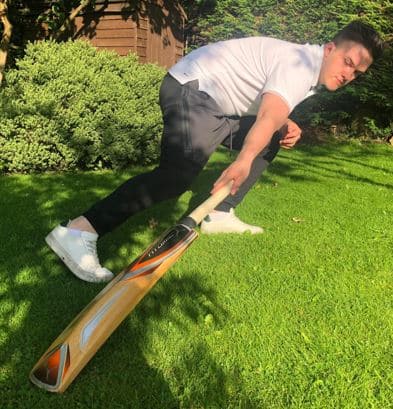
Take Field Placings Into Account When Playing Your Shots
When a fast bowler is trying to get you out, they’ll usually set their field in a way that is designed to trap you. For example, if the fielding side has a fielder positioned at short leg, and 2 fielders out on the boundary covering the hook or the pull, it is likely that the batsman is going to try and get you out by bowling plenty of short balls at you. The positioning of the fielders gives you a good indication of this. If the fast bowler has a field like this set and they are bowling short at you, it may be wise to either leave the ball alone entirely by ducking or weaving out of the way. If you do play a shot at the ball, this comes with a lot of extra risk as there are fielders waiting for you to miscue your shot and hit the ball in the air. Make sure you roll your wrists if you are going to play a shot, as this helps to keep the ball down.
Similarly, if the fast bowler has a predominantly off side field set, with a few slips in place, a man at point and several men on the drive, it is clear that they will be aiming to tempt you into playing a shot at a full ball outside your off stump. If you’re playing a long version of cricket, you can simply leave the ball outside the off stump and try to make the fast bowler bowl a little straighter to you. However, in shorter versions of cricket, you don’t always have the luxury of time. If bowlers are using this tactic in a T20 or a 50 over match I would either try to back away slightly to the leg side and free my arms to hit a powerful shot over the top of the off side fielders, or walk across to the off side so that I can flick the ball into the leg side where there is a significant lack of fielders.
Those are just a couple of examples of how you can use the field that has been set to give you a clue about what type of bowling you’re about to receive. Batting is all about scoring runs so if we can use the field that a bowling team has set against them, we can mess with their game plans and stop them controlling proceedings. Before each ball, I’d recommend having a glance around the field to see where each person has been positioned. After a while, you will start to notice patterns like the ones I have mentioned above, and be able to use them to your advantage.
Try New Ways Of Testing Yourself Against Fast Bowling In Practice
Your first goal when practicing your batting against fast bowling should always be to face plenty of deliveries from actual bowlers. This is massively important because it helps you to get comfortable with watching the bowler during their run up, watching the ball in their hand, seeing the release of the ball and playing your shot. This perfectly replicates the things that you will see during a real cricket match, and that is why it’s the best form of practice you can get. You should make sure that you face as much of this real bowling as possible.
However, what happens if there aren’t enough fast bowlers around to bowl at you? Or what if you want to test yourself even further against quick bowling? If you are facing either of those issues, you may want to think about trying some of the things below:
- Face some deliveries from a bowling machine – Bowling machines are a fantastic tool, and are capable of replicating the speed of fast bowlers very well. Some advanced bowling machines are capable of sending down deliveries over 90mph! The other advantage is that they can be used to target certain areas of the pitch, which will help you work on specific shots. For example, if you want to practice your square cut shot, the bowling machine can be adjusted to bowl deliveries short and wide of your off stump. If your club has access to one of these machines, I’d strongly recommend using them. There are also various bowling machines that you can buy for decent prices that are suitable for home use – like this one from Paceman here! This is a solid investment if you want to be able to practice your batting at home.
- Get a partner to give you some throw downs – Throw downs are a great way of simulating fast bowling when there are no fast bowlers available. All you have to do is get a partner and give them a ball that is suitable for the surface that you’re batting on. Once your partner is ready, have them stand about a pitch length away from you and ask them to throw the ball overarm towards you, making sure that the ball bounces on the pitch before it reaches you. If you really want to test yourself against higher speeds and levels of bounce, you may want to invest in a sidearm thrower that your partner can use to give you throw downs. You can find a great sidearm thrower on Amazon here. This tool will allow your partner to place a ball of their choice in a holder on the end of a long flexible rod, and fire it towards you at high speed. This is what loads of professional batsmen use during their practice sessions, so I’d strongly recommend it to all of you too!
- Try shortening the pitch slightly – To prepare himself to bat against the fastest bowlers, legendary English batsman Geoff Boycott would practice batting on a shorter pitch than usual. Normally, the distance between the bowling crease and the batting crease is around 18 metres. But if we shorten this by a couple of metres and have the bowler bowl at us from something like 16 metres, this can significantly increase the level of challenge we face. If we can become comfortable facing fast bowling from this reduced distance, we will be find it much easier to face bowling from the standard pitch length! I wouldn’t recommend reducing the length of the pitch by more than a couple of metres, as facing fast bowling can be dangerous. Don’t make any changes that you’re not comfortable with!
Practice Regularly – With Your Club & At Home
I’ve probably saved the most important tip until last, and although it may be incredibly obvious, the best thing you can do to improve your batting against fast bowlers is to practice – and practice hard!
Make sure you’re a member of a cricket club and play for as many of the club teams as you can. Try to take part in the practice sessions for each team and make sure you get a good long batting practice at each session. All of these practice sessions will provide you with good opportunities to face the fast bowlers at your club and hone your skills.
Your body will be better prepared to react to fast bowling if you have tons of experience of facing it in practice and during games. The brain works in this way. Basically, the more stimuli you present your brain with, the better it can recognise them and react to them. The stimuli in a batting sense would be the deliveries that you receive from fast bowlers. For example, let’s say you’ve never faced a yorker before. The first time you receive one, you may struggle to react to the flight of the ball because your brain doesn’t have previous experience to call upon. The more times you face them, the better your responses will become due to the brain storing the ones that were successful. This whole process explains how we get better at batting through due to repeated exposure during practice.
Batting during practice sessions with your club is a great way of building the required experience, but if you really want to take your game to the next level, you need to practice your batting regularly at home too. Club practice sessions just don’t occur often enough. Let’s say you get a 1-hour batting session with your club every week. This just isn’t enough time being devoted to practice if you want to become an elite player. I’d aim to get 4-5 hours of practice at home per week as well as your 1-hour session with your club, and try to face as many different types of fast bowling as possible.
If you’re not sure how to practice batting against fast bowling while at home, then I’ve written a post with loads of advice that you can read by clicking here! It’s important to find a few ways that you can practice your skills through the winter months when club cricket isn’t as active.
Conclusion
This post took me a long time to write so I hope all of you manage to find something that you can add to your game! Fast bowlers are intimidating, but if you can master all of the tips that I’ve laid out, you should find yourself in a much better position to deal with quick bowling. If you made it all the way to the end of this post, thank you for reading and I hope you will find plenty more material on this site that can help you on your cricket journey!
